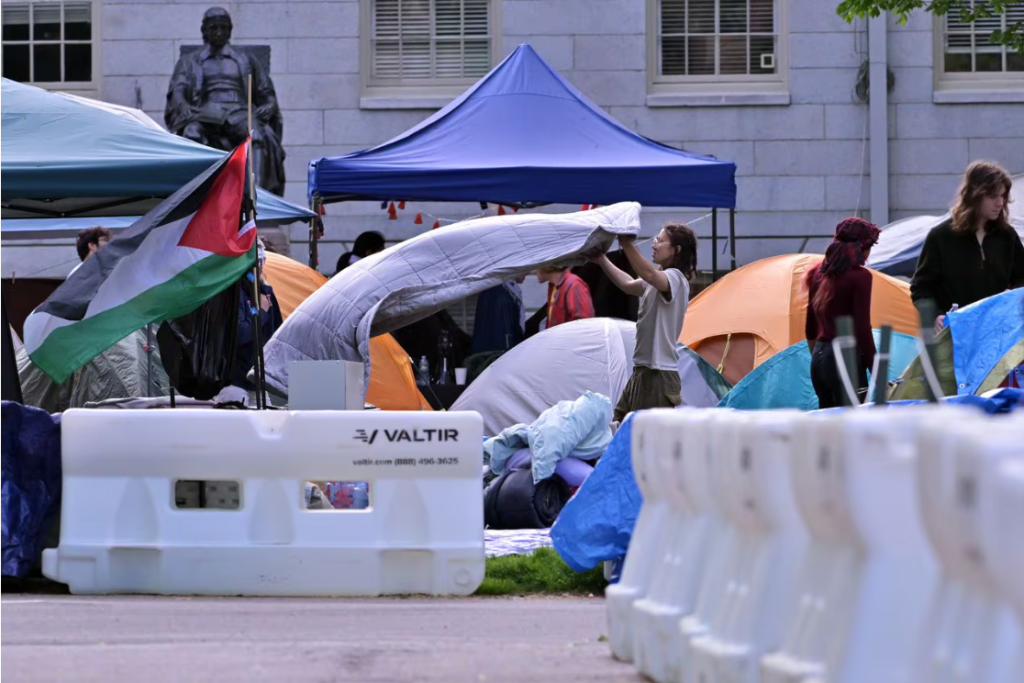【中美创新时报2024 年 5 月 15 日编译讯】(记者温友平编译)周二(14日),波士顿地区最后一个学生抗议营地悄然倒塌,结束了一段因以色列处理对哈马斯战争方式而引发的紧张示威活动,这场示威活动扰乱了大学校园,扰乱了毕业典礼庆典,并引发了数百人被捕。《波士顿环球报》记者约翰·希利亚德 (John Hilliard)、尼克·斯托伊科 (Nick Stoico)、希拉里·伯恩斯 (Hilary Burns) 和麦迪·考 (Maddie Khaw) 对此作了下述报道。
在哈佛校园内设立营地近三周后,学生联盟“走出被占领的巴勒斯坦”哈佛表示,在学校同意继续与抗议者对话并加快 20 多名被停学学生的复职程序后,其成员周一投票决定关闭营地。
关闭营地的决定也是在许多学生随着学年即将结束而离开校园之际做出的。与美国一些校园营地以身穿防弹衣的警察对抗并逮捕示威者的场景不同,哈佛的抗议活动和平结束,抗议者周二大部分时间都在收拾行李。
学生们在一份声明中说:“营地不是我们声援巴勒斯坦的开始或结束。” “我们很清楚,信息披露、撤资、再投资运动——尤其是巴勒斯坦解放运动——现在在国内和国际上都是一股强大的力量。哈佛将不得不考虑到这股力量,直到它撤资。”
哈佛大学临时校长艾伦·加伯周二上午在给大学成员的电子邮件中宣布营地结束。他承认“我们社区中的许多人对战争的悲惨影响感到深切的悲痛”,并表示,世界上“当我们经历事件的痛苦和困扰时,将会出现深刻的分歧和强烈的情感”。
加伯表示:“现在比以往任何时候都更重要的是,我们要尽最大努力,为真正的对话创造条件,树立建立理解、同理心和信任的方式,并追求以我们共同的权利和责任为基础的建设性变革。”
关于学生们的一项核心要求,即哈佛大学将其捐赠基金从任何与以色列做生意的实体中剥离,加伯表示,该捐赠基金不会被用作政治手段的工具。
哈佛大学和全国数十所大学卷入了有关以色列在战争中行为的争论。10 月 7 日,哈马斯入侵以色列,造成约 1,200 人死亡,并劫持了 250 人质,这场战争爆发。据加沙卫生当局称,以色列和哈马斯之间的战斗已导致加沙约 35,000 名巴勒斯坦人死亡。
战争使许多大学社区两极分化。亲巴勒斯坦支持者指责他们的学校与以色列保持经济和其他联系,从而成为同谋,而许多犹太学生则报告了反犹太主义和骚扰事件。
据美联社报道,自 4 月中旬左右以来,校园抗议和营地活动已导致全国各地大学近 2,900 人被捕。
在波士顿地区,抗议者于4月21日晚在艾默生学院、麻省理工学院和塔夫茨大学搭建了营地。几天后,波士顿警方在艾默生旁边的公共走道上搭建的营地中逮捕了近120人。
几个小时后,抗议者在东北校区建立了一个营地;大约两天后,警察扫荡了那场示威活动,逮捕了近 100 人。在与大学官员的谈判陷入僵局后,塔夫茨抗议者于 5 月 3 日拆除了营地。
5 月 8 日,波士顿以外的马萨诸塞大学阿默斯特分校约有 130 人被捕,导致普利策奖获得者、作家科尔森·怀特黑德 (Colson Whitehead) 辞去该校毕业典礼演讲嘉宾的职务。根据校长莫德·曼德尔周二的一封信,伯克郡威廉姆斯学院的一个营地本周也被拆除。
而在布朗大学等一些学校,抗议活动导致管理人员表示他们将考虑从以色列撤资,但这在哈佛大学似乎不太可能。
哈佛学生团体表示,已与校方达成协议,举行会议。但人们怀疑他们是否会导致与以色列的关系破裂:“我们并不抱有幻想,认为哈佛提供的会议会带来实质性的撤资胜利,”他们在声明中表示。
哈佛大学发言人表示,这些会议的目的是让学生就透明度和捐赠基金的运作方式提出问题,而不是谈判哈佛大学是否应该从以色列撤资。
发言人表示,加伯和艺术与科学学院院长霍皮·霍克斯特拉将与营地参与者会面,“进一步讨论他们对中东冲突的看法和观点”。
加伯会见示威者近一周后,哈佛营地结束。他警告他们,如果当天晚上不拆除营地,他们将被无限期停职。周五,20 多名学生收到了非自愿休假通知。
加伯表示,既然营地已经关闭,他将建议所有非自愿缺勤的学生立即进行恢复程序。他还将要求大学纪律委员会“迅速评估”参加营地的学生的案件。
周二在哈佛校园,有迹象表明生活正在恢复正常。地勤人员正在营地附近修剪草坪。该大学似乎也在为 5 月 23 日的毕业典礼做准备。百老汇沿线有一个白色的帐篷,旁边是一堆折叠的讲台。
然而周二,哈佛庭院本身仍然处于封锁之中。媒体人员不得进入校园,离开校园的抗议者也拒绝发表评论。
在里面,有人看到一些示威者停下工作来拥抱或握手。有一次,下午早些时候,几个人正在打排球。
抗议结束后,校园里的情绪复杂,对学校的反应也存在分歧。
哈佛巴勒斯坦司法教职人员的拉拉·吉马努斯在一份声明中对学生抗议者表示欢迎。
吉尔曼努斯说:“他们的公民抗命行为捍卫了我们最基本的言论和结社自由,并提醒我们,我们的解放是相互交织的。”
37 岁的哈佛校友罗特姆·斯皮格勒 (Rotem Spiegler) 住在校园里,反对营地。她拿着一张 10 月 7 日一名小男孩被劫为人质的海报,走向聚集在院子一扇门口的记者,然后在肩膀上缠了一面以色列国旗。
斯皮格勒说:“我代表自己说话,但我认为很多学生、教职员工都有同样的感觉——大学没有保护我们,也没有让我们的声音被听到,这让我们很失望。”
27 岁的哈佛大学研究生莱安德罗·乌尔巴诺 (Leandro Urbano) 对加伯和学生们都表示赞赏。他说,校长的回应是“坚定的”但“专业的”,而营地里的学生也保持了组织性和“文明”。
乌尔巴诺说:“从处理的方式来看,我真的觉得即使营地还在继续,我们也可以开始。”
21 岁的杰弗里·关 (Jeffrey Kwan) 学习物理和数学,他是认为哈佛大学在惩戒示威者方面做得太过分的学生之一。
“学生能够做这类事情很重要,”关说。 “我对大学的推迟程度不太满意。”
《波士顿环球报》记者莉拉·亨佩尔-埃杰斯为本报告做出了贡献。
题图:周二(14日),哈佛学生在哈佛庭院拆散了他们的营地。JOSH REYNOLDS FOR THE BOSTON GLOBE
附原英文报道:
At Harvard, Greater Boston’s last campus encampment folds up its tents
By John Hilliard, Nick Stoico, Hilary Burns and Maddie Khaw Globe Staff and Globe Correspondent,Updated May 14, 2024
CAMBRIDGE — The last of the student protest encampments in the Boston area came down quietly Tuesday, ending a tense period of demonstrations over Israel’s handling of its war against Hamas that roiled college campuses, disrupted commencement celebrations, and triggered hundreds of arrests.
Nearly three weeks after setting up camp inside Harvard Yard, the student coalition Harvard Out of Occupied Palestine said its members voted Monday to close down its encampment after the university agreed to continue dialogue with protesters and expedite reinstatement procedures for more than 20 suspended students.
The decision to wind down the encampment also comes as many students have left campus with the academic year drawing to a close. And unlike some campus encampments in the United States that ended with scenes of police in body armor confronting and arresting demonstrators, the Harvard protest ended peacefully as protesters spent much of Tuesday packing up their gear.
“The encampment is not the start or the end of our solidarity with Palestine,” the students said in a statement. “It is clear to us that the movement for disclosure, divestment, reinvestment — and above, all, for Palestinian liberation — is now a powerful force, both nationally and internationally. Harvard will have to reckon with that force until it divests.”
Harvard interim president Alan Garber announced the end of the encampment in an e-mail to university members Tuesday morning. He acknowledged the “profound grief that many in our community feel over the tragic effects” of the war, and said there will be “deep disagreements and strongly felt emotions as we experience pain and distress over events” in the world.
“Now more than ever, it is crucial to do what we do at our best, creating conditions for true dialogue, modeling ways to build understanding, empathy, and trust, and pursuing constructive change anchored in the rights and responsibilities we share,” Garber wrote.
On one of the students’ central demands, that Harvard divest its endowment from any entities doing business with Israel, Garber has said the endowment will not be used as a tool for political means.
Harvard and scores of universities across the country were caught up in the debate over Israel’s conduct in the war, which erupted Oct. 7 when Hamas invaded Israel, killed about 1,200 people, and took 250 hostage. Fighting between Israel and Hamas has led to the deaths of about 35,000 Palestinians in Gaza, according to health authorities there.
The war has polarized many college communities. Pro-Palestinian supporters accused their schools of complicity by maintaining financial and other ties with Israel, while many Jewish students reported incidents of antisemitism and harassment.
Campus protests and encampments have led to nearly 2,900 arrests at universities across the country since around mid-April, according to the Associated Press.
In the Boston area, protesters erected encampments at Emerson College, MIT, and Tufts University on the night of April 21. A few days later, Boston police arrested nearly 120 people from the encampment erected on a public walkway next to Emerson.
Hours later, protesters built an encampment on the Northeastern campus; police swept through that demonstration about two days later and arrested nearly 100. Tufts protesters dismantled their encampment on May 3 after negotiations with university officials stalled.
Beyond Boston, about 130 people were arrested at the University of Massachusetts Amherst on May 8, prompting Pulitzer Prize-winning author Colson Whitehead to withdraw as the university’s commencement speaker. An encampment at Williams College in the Berkshires was also being taken down this week, according to a letter Tuesday from president Maud Mandel.
While at some schools, such as at Brown University, the protests resulted in administrators saying they will consider divestment from Israel, that appeared unlikely at Harvard.
The Harvard student group said it had reached an agreement with the university to hold meetings. But it was skeptical they will result in breaking a relationship with Israel: “We are under no illusions that the meetings Harvard offered are material divestment wins,” they said in their statement.
A Harvard spokesperson said the meetings are intended to allow students to ask questions about transparency and how the endowment operates, not to negotiate whether Harvard should divest from Israel.
Garber and Faculty of Arts and Sciences dean Hopi Hoekstra will meet with encampment participants “for further discussion on their views and perspectives regarding the conflict in the Middle East,” the spokesperson said.
The Harvard encampment ended nearly a week after Garber met with demonstrators. He warned them they would be indefinitely suspended if the camp wasn’t dismantled that evening; involuntary leave notices went out Friday to more than 20 students.
Now that the encampment is down, Garber said he would recommend prompt reinstatement proceedings for all students who have been placed on involuntary leaves of absence. He will also ask university disciplinary boards to “evaluate expeditiously” the cases of students who participated in the encampment.
On the Harvard campus Tuesday, there were signs that life was returning to normal. Grounds crews were mowing the lawn near the camp. The university also appeared to be preparing for commencement on May 23. A white tent stood along Broadway next to stacks of folded platforms.
Yet Harvard Yard itself remained under lock and key Tuesday. Media members were not allowed on the grounds, and protesters who left the campus declined to comment.
Inside, some demonstrators were seen stopping their work to share a hug or shake hands. At one point, several were playing volleyball early in the afternoon.
As the protest ended, there were mixed feelings on campus — and division over the university’s response.
Lara Jirmanus, with Harvard Faculty and Staff for Justice in Palestine, hailed the student protesters in a statement.
“Their acts of civil disobedience have safeguarded our most basic freedoms of speech and association and have reminded us that our liberations are intertwined,” Jirmanus said.
Rotem Spiegler, 37, a Harvard alum who lives on campus and opposed the encampment, approached reporters gathered at one of the yard’s gates with a poster of a young boy taken hostage on Oct. 7, and then wrapped an Israeli flag around her shoulders.
“I’m speaking for myself, but I think that a lot of students, faculty, and staff feel the same way — that the university has majorly let us down by not protecting us or letting us get our voices heard,” Spiegler said.
Leandro Urbano, 27, a Harvard graduate student, praised both Garber and students. The president’s response was “firm” but “professional,” while students at the encampment also remained organized and “civilized,” he said.
“The way it was being dealt with, I really felt like we could have commencement even if the encampment was going on,” Urbano said.
Jeffrey Kwan, 21, who studies physics and math, was among the students who believed Harvard went too far in disciplining demonstrators.
“It’s important that students be able to do this sort of thing,” Kwan said. “I’m not super happy about how much the university pushed back.”
Globe correspondent Lila Hempel-Edgers contributed to this report.

